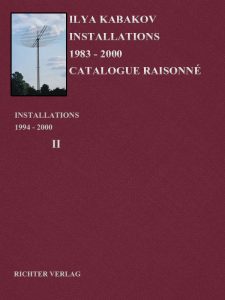The Tennis Game
YEAR: 1996
CATALOG NUMBER: 95
PROVENANCE
Version 1
Collection of the artist.
Version 2
Collection of the artist.
EXHIBITIONS
Version 1 (with Pavel Pepperstein)
Rundetårn, Copenhagen, Denmark
Strangers in the Arctic: ‘Ultima Thule’ and Modernity, 8 March – 28 April 1996
Porin Taidemuseo, Pori, Finland
Muukalaisia arktisessa: Ultima Thule ja moderni aika (Strangers in the Arctic. ‘Ultima Thule’ and Modernity), 15 June – 1 September 1996
Art Gallery of Ontario, Toronto, Canada
Strangers in the Arctic, 25 June – 1 September 1997
Version 2, (with Boris Groys)
Städtische Galerie im Zentrum für Kunst und Medientechnologie, Karlsruhe, Germany
Herausforderung Tier – Von Beuys bis Kabakov, 15 April – 30 July 2000
Galleria Continua, San Gimignano, Italy
Ilya Kabakov, 31 March – 27 May 2001.
DESCRIPTION
The installation is housed in a large rectangular hall resembling a sort of sports hall, a hall for playing tennis. The entire middle of the hall is occupied by a tennis court. A net is stretched across the court. (The court lines are made of white strips of paper so as not to ruin the floor of the gallery.) Sixteen benches stand along the edges of the court for viewers. Along the walls behind the benches, surrounding the court, along the entire perimeter of the hall, there are 14 boards of ‘information’ about the game taking place on the court, about the competition between two players. In terms of appearance, these boards resemble school boards – they are standing on wooden pedestals, they are colored black and the texts on them are written in chalk. A lighted ‘scoreboard,’ with information about which of the players has the ‘serve,’ is attached to the left above each of the boards. Above on the right is a small television screen showing the uninterrupted film of this match. The numbers between the ‘scoreboard’ and the screen – 1, 2, 3, 4, etc. – indicate the number of the set. In this way, what we have before us is a visual demonstration of a tennis match between its participants – they are the very authors of the installation: Ilya Kabakov and Pavel Pepperstein. Of course, the real information about the match is not in the movement of the partners on the screen, and not in what is on the court – on it, on this court, there is nothing and nothing is going on – but rather in the texts written in chalk on these 16 boards.
Instruction Boards
Each board is divided in half by a vertical white line. Five questions are written in chalk by hand on the left side: these are the same ‘five serves of the match’ that the ‘players’ make, the last name of the player is indicated on the scoreboard as the ‘server.’ On the right side of the board, five answers to these questions are written. These are the answers ‘receiving’ the serve.
On the next board, the situation is reversed. The one who ‘received the ball’ now ‘serves’ it, i.e., he poses his own five questions, and the one who served before now answers them. So it goes, successively, board after board, each player in turns first asking, then answering, completing the full ‘circle’ of the entire ‘match’ from ‘set No. 1’ to ‘set No. 16.’ It is not difficult to calculate that each player has to answer 80 questions and ask 80 questions during the course of the ‘match.’
All the texts will be written on the boards ‘by hand’ in English, translations into Finnish and Danish will be arranged next to the boards.
An ‘audio component’ is also envisioned for the installation. This consists of the sounds of a ball hitting the ground and periodic applause which will make the entire installation ‘rhythmic.’
CONCEPT OF THE INSTALLATION
It is easy to see in the concept of this installation an analogy with a Medieval disputation, which at that time was nothing but a unique kind of intellectual competition. In such a disputation tournament, a preliminary topic was posed which was then discussed by the two players. It was assumed that the two of them belonged to different ‘camps,’ to different traditions, and the adventures of such a meeting were rich in sharp lunges, blows, and their blocks.
In the tournament by the name The Tennis Game, a preliminary topic also exists: ‘Strangers in the Arctic,’ and just like in a classical tournament, it – this ‘topic’ – will be discussed from various positions by both of the ‘tennis players.’ The topic of the exhibit serving as the framework for this installation – the topic of a ‘stranger on foreign territory’ – is sufficiently close and comprehensible to both of the participants of the match, this topic has already been discussed by them rather often – we could hope that this time the battle would be uncompromising.
What is the result of this ‘match,’ who is the victor? Here we can only quote the person who in our time resurrected the tradition of the Olympic games, who pronounced the following words: ‘It is more important to participate in these games than to win.’ This applies to the participants themselves. But what is the position of the viewer/reader in such a case? It is not nearly so obvious, and each one has to judge independently what has occurred before him on the court.
Images
Literature








